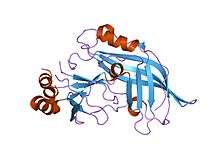VP40
| VP40 | |||||||||
|---|---|---|---|---|---|---|---|---|---|
 Crystal structure of the matrix protein VP40 from the Ebola virus | |||||||||
| Identifiers | |||||||||
| Symbol | VP40 | ||||||||
| Pfam | PF07447 | ||||||||
| InterPro | IPR008986 | ||||||||
| SCOP | 1h2c | ||||||||
| SUPERFAMILY | 1h2c | ||||||||
| |||||||||
In molecular biology, VP40 is the name of a Viral matrix protein. Most commonly it is found in the Ebola virus (EBOV), a type of non-segmented, negative-strand RNA virus. Ebola virus causes a severe and often fatal haemorrhagic fever in humans, known as Ebola virus disease. The virus matrix protein VP40 is a major structural protein that plays a central role in virus assembly and budding at the plasma membrane of infected cells. VP40 proteins work by associating with cellular membranes, interacting with the cytoplasmic tails of glycoproteins and binding to the ribonucleoprotein complex.
Structure
The VP40 monomer consists of two protein domains, the N-terminal oligomerization domain and the C-terminal membrane-binding domain, connected by a flexible linker. Both the N- and C-terminal domains fold into beta sandwich structures of similar topology.[1] Within the N-terminal domain are two overlapping L-domains with the sequences PTAP and PPEY at residues 7 to13, which are required for efficient budding.[2] L-domains are thought to mediate their function in budding through their interaction with specific host cellular proteins, such as tsg101 and vps-4.[3]
Function
VP40 coordinates numerous functions in the viral life cycle of the Ebola virus. These include: regulation of viral transcription, morphogenesis, packaging and budding of mature virions. VP40 goes through intermediate states of assembly (e.g. octamers). It has been noted that proteins encoded by EBOV (VP30, VP35, and VP40) act independently as suppressors of RNA silencing, indicating that the virus actively resists cellular RNAi during replication.[4]
Significance of VP40
Study of the matrix protein VP40 is important due to the high mortality rate of the Ebola virus, which is listed as a WHO Risk Group 4 Pathogen, an HHS Select Agent, an NIH/NIAID Category A Priority Pathogen, a CDC Category A Bioterrorism Agent, and a Biological Agent for Export Control by the Australia Group. Expression of the matrix protein VP40 is sufficient to generate virus-like particles in a mammalian host that are remarkably indistinguishable from live virus, from a morphological standpoint[4]
References
- ↑ Dessen A, Volchkov V, Dolnik O, Klenk HD, Weissenhorn W (August 2000). "Crystal structure of the matrix protein VP40 from Ebola virus". EMBO J. 19 (16): 4228–36. doi:10.1093/emboj/19.16.4228. PMC 302032
 . PMID 10944105.
. PMID 10944105. - ↑ Timmins J, Schoehn G, Ricard-Blum S, Scianimanico S, Vernet T, Ruigrok RW, Weissenhorn W (February 2003). "Ebola virus matrix protein VP40 interaction with human cellular factors Tsg101 and Nedd4". J. Mol. Biol. 326 (2): 493–502. doi:10.1016/S0022-2836(02)01406-7. PMID 12559917.
- ↑ Licata JM, Simpson-Holley M, Wright NT, Han Z, Paragas J, Harty RN (February 2003). "Overlapping motifs (PTAP and PPEY) within the Ebola virus VP40 protein function independently as late budding domains: involvement of host proteins TSG101 and VPS-4". J. Virol. 77 (3): 1812–9. doi:10.1128/jvi.77.3.1812-1819.2003. PMC 140960
 . PMID 12525615.
. PMID 12525615. - 1 2 Silva LP, Vanzile M, Bavari S, Aman JM, Schriemer DC (2012). "Assembly of Ebola Virus Matrix Protein VP40 Is Regulated by Latch-Like Properties of N and C Terminal Tails.". PLoS ONE. 7 (7): e39978. doi:10.1371/journal.pone.0039978. PMC 3390324
 . PMID 22792204.
. PMID 22792204.
This article incorporates text from the public domain Pfam and InterPro IPR008986